Updated 24 Mar 2008
|
WIRKSWORTH Parish Records 1600-1900
|
|
Wirksworth Community Newsletter
|
Articles about local history around Wirksworth
written for the "Wirksworth Community Newsletter"
against a deadline of the end of each month,
and taken up by the Newsletter's editor Rob James.
|
Title |
Deadline |
|
31dec2007 |
|
30nov2007 |
|
31oct2007 |
|
30sep2007 |
|
31aug2007 |
|
31jul2007 |
|
30jun2007 |
|
31may2007 |
|
30apr2007 |
|
31mar2007 |
|
08mar2007 |
|
Title |
Deadline |
|
31jan2008 |
|
29feb2008 |
|
31mar2008 |
|
30apr2008 |
|
31may2008 |
|
30jun2008 |
|
31jul2008 |
|
31aug2008 |
|
30sep2008 |
|
31oct2008 |
|
30nov2008 |
|
John Cotterill's grandfather.
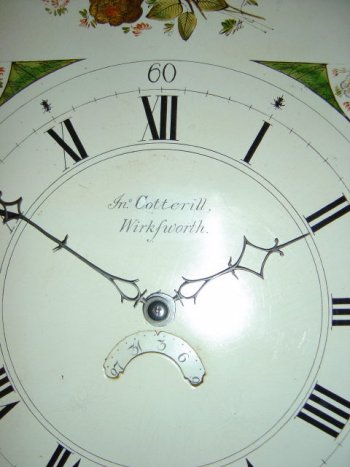 |
William Evans' grandfather.
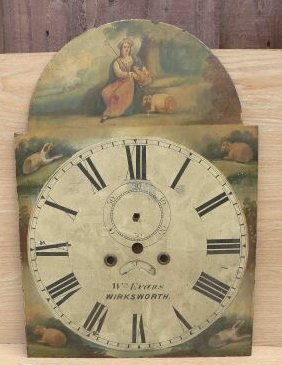 |
John Cotterill and William Evans both moved to Wirksworth
in the 1800s as watchmakers and jewellers. They also made
grandfather clocks, two of which survived to be offered
at Auction at Ebay. If any reader has a similar grandfather
clock, please contact the author with details.
John Cotterill was born in Bakewell in 1780, and is listed in Trade
Directories for 1821-27-31-35-46 as being established
in Coldwell Street, Wirksworth, as a watch and clockmaker.
In 1807 he married Elizabeth Griffin.
Elizabeth died in 1835 aged 67, but John lived on another 27 years,
dying at Wirksworth in 1862 aged 82.
John was born before photography, so an example of his handiwork
must stand in place of a cabinet card.
William Evans was born in Nottingham, and moved to Wirksworth as a young
unmarried watchmaker before he was 21. His wife Mary Cooper from
Nottinghamshire died at 29, but he married Hannah a year later (also from
Nottinghamshire) and had 4 children by her.
William described himself as a watchmaker, watch and clockmaker, jeweller
and (aged 50) as a Master watchmaker. His shop was in St John Street,
Wirksworth for 40 years from 1851, when he moved to better premises on Dale Street,
Matlock. His eldest son William died at 18, but second son Charles trained
as a jeweller and "refractionist" (today called an optician) and eventually
took over his father's business in Matlock.
An example of William Evans' work is shown. It is a grandfather clock dial
from around 1860 and measures 14" by 20". The paintings on the face
surround show a shepardess in the arch and dogs and sheep in the corners.
It has its original winding hole collett and datewheel, with four short
dial feet at the back.
Bertram Haworth (1904-1998) remembers William Evans' business near the Market
Place, Wirksworth, and describes a Mr Millington who took over when Evans
moved to Matlock.
Below, on the Market side, was Mr. Millington's shop. A remarkable man - who
could clean and repair any mechanism if he so wished. He was one of our
real characters. Apprenticed in Derby, he cycled down to Sadler Gate in
Derby on Sunday evening to be ready to start with his foreman at 7 o'clock
am Monday. At night he slept under the counter in the shop and returned
to Wirksworth on Saturday night after 8pm. Later he worked in Wirksworth
and took over the business when Mr. Evans the proprietor left to open a
shop in Matlock Dale Road. One prospers and one just lives and enjoys
life. Mr. Millington was a keen gardener and an unscrupulous competitor
at the local horticultural shows. So flagrant were his actions that
finally he was (de)barred from all competitions. He also was a keen
rabbit man and always kept ferrets and gun dogs. He had a dog which
slept under his work bench next to the ferret box. His shop was the
meeting place for all the men of his ken. Little work was done, but
much libelous conversation was heard. He was also a great beer drinker.
A type of Wirksworthian we shall never see again.
John Palmer
Author of Wirksworth website
www.wirksworth.org.uk
|
|
Old Norman font - 13th century
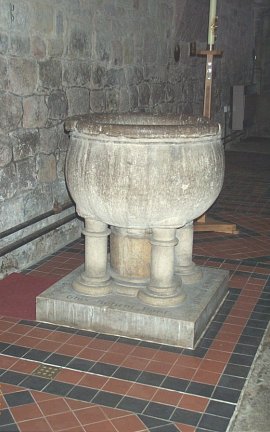 |
New Restoration font - from 1662
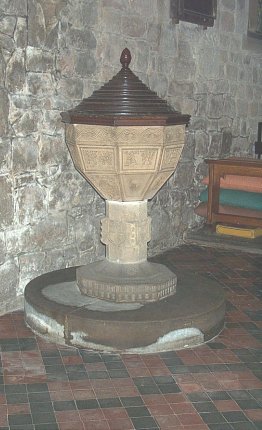 |
St Mary's church in Wirksworth has two fonts, covering 750 years of use.
Together they have baptised over 6 times the town's population today.
The old Norman font perhaps dates back to 1250, and was mounted on a
modern base in 1895 by Tunstall Smith, vicar for 42 years. Lined with
locally-mined lead and unusually large, (two feet ten inches in diameter
and two feet in depth), it could hold half a ton of water.
The shape of the massive bowl is "like a gipsy's pot or kettle",
easy for baptisms by immersion. Norman fonts usually have quite small bowls.
In 1662 St Mary's Church Wirksworth had a new font, as a thankoffering
for the return of Good King Charles' Golden Days and the new Prayer Book.
In Restoration style, with a heavy wooden cover as protection against
sorcery, it stands at the East end of the South aisle and bears the
initials of the Vicar Thomas Browne and his Churchwardens.
The Churchwarden's Accounts for 1662 record the new font expenses for
masons, apothecary, carver, joiners, setting up, painting, the pulley
(to lift that heavy cover), leading and finally ale in celebration of
work finished (the church usually rewarded its workmen with ale).
The population of the old Wirksworth Parish was then about 3,000, and
remained constant until 1725, when the Industrial Revolution caused it
to increase to 7,000 in 100 years.
The Parish was more extensive than now, estimated populations were:
Wirksworth town (700), Ashleyhay (300), Hopton (287), Alderwasley (287),
Itheridghay (287), Callow (237), Biggen (225), Cromford (225),
Middleton (225), Ible (112) and Imbrookgrange (112)
The new font averaged 140 baptisms per year 1662-8. Births were not
distributed
evenly through the year though. A slight peak in births in March was
followed by a minimum in July. A medical friend explains:
"Length of Day governs hormone production within females making them more
fertile. Even today March seems to have a peak of births".
In the 17th century, most people were very religious and believed
unbaptised children would not go to heaven. The delay between birth and
baptism was about a week, and 94% of children had been immersed in
the new font by 3 weeks old.
By 1800, habits had changed. Many more children were being baptised
later in life. Nearly one in four were baptised more than a year after
birth. The Wirksworth record is held by Edward Cordin, born 1814 and
not baptised until 1883. Neither were Baptisms spread evenly throughout
the year. The monthly average was 16 baptisms - except for September.
That month averaged 56 baptisms, the majority of which took place on
just two days around the middle of September. It was a kind of "Baptism
Festival", perhaps to celebrate the Harvest-Home. The church would be
packed with screaming children, proud parents and well-dressed family.
Fathers often baptised several children at the same time, perhaps they
were offered a "job lot". The author believes the Wirksworth record is
seven children (none twins) baptised at the same time.
By 1900 the new font had seen 30,000 baptisms, young and old. But the
baptism rate was falling off, for several reasons. The old Wirksworth
parish had been reduced in size, the increase in Nonconformity and the
rise in Secularism all helped to reduce wear and tear on the font. In
1891-9 there were only 114 baptisms on average, fewer than when the
font was new, nearly 240 years ago.
There were 4,411 recorded baptisms in the old font 1608-1661, averaging
83 per year. At a guess, the old font also saw nearly 30,000 baptisms,
between 1250 and 1661, although there are only records for the last
53 years of its use.
The author has no records covering the last century of the new font.
Wirksworth Parish Registers are now deposited at the Derbyshire Record
Office, Matlock. They contain about
88,000 entries for 1608-1899. These have been transcribed by the author and
are held on database,
which is the source for the numbers quoted in this article. An indexed
list of these entries can be viewed, free, on the Wirksworth website.
John Palmer
Author of Wirksworth website
www.wirksworth.org.uk
|
|
Knobstick wedding in Wirksworth
|
A Knobstick Wedding was the wedding of a pregnant single woman to the putative father-to-be, under pressure from the parish vestry. The churchwardens attended to see that the ceremony was performed, and the name is derived from their staves of office.
From "The Times, 6 Oct 1829.
"One of those illegal celebrations of matrimony which are termed by the peasantry 'knobstick weddings', lately took place at Wirksworth. The parties forced into the blessed state are William Saxton, a slender-witted man, 24 years of age, and Lydia Brooks, some 15 years older, who has a
wooden leg, both of them paupers - the man chargeable to Sheffield, the woman to Middleton, near Matlock".
[i.e. the woman had just been removed from Sheffield to Middleton as her legal place of settlement.]
The husband explained to the parish overseers that Liddie Brooks "whom I never know'd, sweared a child on me as soon as she'd gotten to Middleton, where you sent her. So when she'd swear'd it, they sent o'er for me to filiate it; first of all they took me to Derby, and then, only because I kno'd nothing about it, they remanded me to Wirksworth gaol. When I had
lied in gaol some time, the gentlemen I telled you of comes to me, and says they: 'Why, man, you mun marry this lass'."
"Ay", says I: "I mun as well, sin you mak me father o' her bairns". Then says they again: "If you don't you know you'll lie in gaol for a twelvemonth, and happen be hanged after all. ... They gied me some liquor, and I being scared, gied 'em my promise".
"In this state of drunkenness, without hat or shoes, handcuffed, the pauper was taken from goal to Matlock, where a licence of marriage was procured and paid for by the overseers. ... In the morning the overseers appeared before
the prison doors, and summoned the captive. To prevent mistakes, it was thought proper that a pair of steel ruffles (handcuffs) should unite the impatient groom to one of the overseers, and in this state, by a circuitous route, the party reached the church of Wirksworth. Here, equally under the
influence of the parish guides, stood the wooden-legged bride; and here poor Saxton, who had been frightened into a belief that no choice existed between hanging and marrying, submitted to take for better or worse Lydia Brooks."
[They were married by licence, William signed the marriage entry with a
cross - he could not write. Lydia signed with a childlike hand].
Apparently the responsible overseers of the poor were afterwards summoned before a magistrate ... "but being unable to give any explanation of their conduct, they were held to bail to appear at the Derby sessions, to answer a
prosecution for fraudulently procuring the marriage of William Saxton with Lydia Brooks, with the intent to defraud the township of Sheffield, who had been removed from Sheffield to Middleton."
[David Walker and Philip Bateman were both Parish representatives on the Board of Guardians. Walker was
also publican at the Rising Sun Inn, Rise end, Middleton and Bateman was a school master at Middleton.]
"Philip BATEMAN & David WALKER were parish officers in Middleton & effected to procure a marriage between William Saxon & Lydia Brooks. William said he saw Lydia for the first time on 2nd Aug and was pressured to marry her on the 13 Aug by the 2 defendants. He was promised money & threatened with
imprisonment. He was taken by gig to Chesterfield then taken back to Wirksworth to be taken before the magistrate there. Presumably the magistrates in Chesterfield wouldn't come to the party ! He was put in gaol for 3 days then taken to Matlock Bath where David Walker paid for a marriage licence from a Rev Ward there. William then taken to Wirksworth church and married to Lydia. Two days later William left Lydia.
David Walker was said to have a public house in Middleton. Both defendants were acquitted."
The Census seems to show the couple stayed together:
1841 Census - Radford Row, Sheffield. There was a William Saxton, 35, labourer, born in Yorkshire and Lydia Saxton (aged 35!!!!) NOT born in the county.
1851 Census - No 5 at back of Radford Row, Sheffield
William Saxton, 46, widower, Parish Relief Labourer, born Masbro YKS, was a lodger
It looks as though William finally outlived his wife Lydia after 25 years of married bliss!
John Palmer
Author of Wirksworth website
www.wirksworth.org.uk
|
|
Wirksworth Solar System 1866
|
John DEAN was only 13 when he completed a remarkable "Chart of the Solar System" in 1866. He was a pupil at "J.W.Beeson's Excelsior Schools" in Coldwell Street, in Wirksworth.
The chart is drawn on stiff white paper, about 36 x 24 inches. A dark blue border show the signs of the Zodiac. Concentric cirles show the orbits of the planets.
His chart shows 7 planets (Pluto was discovered 70 years later) and many moons. It shows the Asteroids between Mars and Jupiter, explains how tides and eclipses work, and shows the orbit of a comet (on a nicely drawn parabolic orbit). The chart is still well preserved and in the private ownership of a gentleman in Derby, a descendant of John DEAN.
The chart appears correct as the solar sytem was understood in 1866, except for 4 curious mistakes. Neptune is not shown, although it had been discovered in 1846. Uranus is shown with 6 moons, Herschel's mistaken sightings of 6 by 1794 were not corrected until 1851 by Lassell. Saturn is shown with 7 moons, the eighth was discovered in 1848. Only 4 asteroids are shown, all that were known before 1845, although 85 were known by 1866. It looks likely that John Dean was working from an almanac or astronomy textbook printed before 1845, 20 years before he drew his chart!
John DEAN was born in Kirk Ireton in 1853. His father Samuel was a farmer, as was his grandfather John. Between 1854 and 1884 Samuel ran the well known Barley Mow Inn at Kirk Ireton, dating back to 1683, originally a farm house and coaching inn before becoming a public house. Samuel had a No Smoking rule in the Barley Mow, saying "Leave your pipes outside"! John was the eldest of 3 sons and 3 daughters (two of the girls were twins). Several Census entries show the family 1841-1901, although John disappears from the author's records after 1871, when he is shown as a draper's apprentice.
John was a pupil at James W.Beeson's Academy in Coldwell Street, Wirksworth. James Beeson came from Derby around 1860 to teach at Wirksworth Grammar School, which was doing poorly. After a disagreement with the headmaster Herbert Harris he set up a private school about 1861 for children when they left state education at 11 years old. John Dean was probably a pupil at the academy from 1864 to 1870. The school was well known for "mind-stretching projects", another example is the 1861 Cashbook (see the Wirksworth website). The Academy became known as "Excelsior Schools", meaning "Ever higher" from the Longfellow poem.
The chart owner writes:"John Dean ended up with a drapers shop in St Peters St, Derby, initially named Hurd and Dean, subsequently John Dean.....They were just up from Boots corner on East St, opposite the east end of St Peters church. John lived in Highfield Road, Derby and had two daughters, Muriel and Constance."
At 44 John Dean retired from his drapery business and took a farm near Idridgehay. He became a conservative Councillor for Derby in 1897, and later a Magistrate. At the time of his death in 1918 he was chairman of the Tramways Committee, and also served on the Audit and Finance, Borough Developement, Estates, and Plant and Stores Committee. He was deeply interested in agricultural matters and the breeding of shire horses, and was a member of the Council of the Derbyshire Agricultural Society, at whose annual exhibition he frequently acted in the capacity of yard steward. As a magistrate "He was always inclined to show mercy and pity to those who had the misfortune to appear before the Court, and he was actuated by an earnest desire to do what was right."
John Dean died in 1918 at 65 after a long illness, leaving a wife and two daughters.
Pictures and more information about John Dean, his chart and later life can be found on the Wirksworth website at www.Wirksworth.org.uk/X533.htm
John Palmer
Author of Wirksworth website
www.wirksworth.org.uk
|
|
From Russia with Love, 1904 |
Just before the Christmas holidays 1904, a 9 year old boarder at
Wirksworth Grammar School was called to see his headmaster.
Alfred Berridge M.A. handed a coloured postcard to young Thomas
K.Breakell with a sniff. "From your father in Russia, I think. You
look well enough to me."
The postcard had a lovely hand-coloured picture of a magnificent
cathedral, with Postkarte in German script. Below it reads:
Wien Stefanskirche. The address covers the whole of the other side:
Master T.K.Breakell, c/o Mr A.Berridge Esq M.A.,Wirksworth in Derby, England.
The Magenta stamp has a double-headed eagle with Postage stamp and
4 Kopeks in Russian. The postmark shows 19 December 1904 and sent
from Batum in Georgia. Squeezed below the picture is the memorable message
from a loving father far away: "I hope you have no cold or chilblain"
(See pictures of this postcard on
www.wirksworth.org.uk/X485.htm)
Father Thomas was a 42 year old mining engineer from Lancashire. The family
was living at
The Hall, Brassington
with mother Mary, Uncle William, Granny
Emma, Aunt Ann and Annie the Servant. Thomas Senior was a clever man, who
patented a grinding and pulverizing Mill in 1908. His brother William was a
Mining Accountant.
In 1904 Thomas senior went on a business trip to Georgia. He travelled
by steam train from Wirksworth to London and on to Dover. Then by steam ship
to Calais and again by steam train to Paris. Here he caught the famous Orient Express to Strasbourg, Munich, Vienna, Budapest, Bucharest and Constantinople. Then another ship across the Black Sea to Batum near the Armenian border. In Vienna he bought several fine Austrian postcards to send to his relatives back in England.
Batum was an important port on the Black Sea. It is the last stop of the
Trans-Caucasian Railway and the Baku oil pipeline. Sub-tropical Palm trees,
lemon and orange trees grow there. In 1901 Josef Dzhugashvili age 26 lived
in the city organizing strikes. He later became known as Joseph Stalin.
Young Thomas K.Breakell turns up again ten years later. He joined the Duke
of Cornwall's Light Infantry, transferred to the Royal Flying Corps and
survived to become a lieutenant in the newly formed RAF. He owned a
"Kodak No.3A Autographic Model B5" camera, which may have
been used for the new art of aerial reconnaisance.
A fellow researcher Stuart Flint has unearthed some more information on
young Thomas:
"Thomas K Breakell lived at Brassington Hall up to joining the Flying
Corp..I have it on good authority from persons who remember him, that he
was a "dare devil" who owned a smal biplane which he often landed on a
field belonging to the Hardy family Farmers of Brassington.
Jan tells me that his father Thomas was a friend of Douglas Bader who
often visited Brassington..Thomas K Breakell I have to tell you, only
landed the once at Hardy's field when Thomas's father Thomas Breakell
was about to breath his last breathe..
Thomas K had permission to fly from his base to Brassington and landed
at Hardy's farm.. Thomas Breakell also is recorded as having flown
under Tower Bridge as I believe Bader did
Apparently Thomas K Breakell built a small plane in a field at the
frontage of Brassington Hall, but it was never to fly..."
Who would have thought life would become so exciting when Thomas was
a 9 year old schoolboy at Wirksworth Grammar School!
John Palmer
Author of Wirksworth website
www.wirksworth.org.uk
|
|
A dusty, musty old book, now nearly 400 years old, holds a strange
story connecting Wirksworth with Persia in 1611. It reads:
"Nov 1611. For John de Kraino Kramsky in the great dukedom of Julhuama
Susiana or Cusestan. 15 shillings"
A picture of the entry is on the Wirksworth website at:
www.wirksworth.org.uk/A87-Kram.htm.
The book is the Churchwarden's Accounts for Wirksworth,
a fascinating read to
be found in the Derbyshire Records Office. It has been transcribed
by the Author and can be read on www.wirksworth.org.uk/CWA.htm.
In those days, nearly everyone
went to Church on a Sunday, and the Vicar (after his sermon) would tell
the congregation about a good cause, then make a collection. Fifteen
shillings was collected for John Kramsky, a good sum of money worth
about 20 day's wages for a labourer in Wirksworth.
The word "Julhuama" has been half crossed out. But where was it?
The only "Great Dukedom" in Europe at the time was Lithuania and it was
part of the Kingdom of Poland. This agrees with the Slavic name
"Kramsky", which was common in Poland then. In those
days Lithuania stretched from the Baltic to the Black Sea, and included
parts of today's Poland, Estonia, Latvia, Belorussia, Russia, the Ukraine
and Moldavia. Near Lublin is a village today called "Krainow",
perhaps this is where John Kramsky lived?
What about those strange places "Susiana" and "Cusestan"?
They were certainly not in Lithuania, but were regions of Persia, a great
and historic empire today renamed Iran. So what's the connection between
Lithuania and Persia?
In the 17th century Poland-Lithuania had a border with the Turkish
Empire in the South, in the Moldovian and Crimean regions. There was always
fighting along the borderline, even when there was no real war. Maybe
John Kramsky was captured by Muslims during such a conflict, and sold as
a slave to Persia?
This might sound melodramatic, as if taken from a cheap novel. But such
things happened very often in those times. In fact, Christians kidnapped
and enslaved by Muslims in South-East Europe were so common that in many
European countries there were slave funds. The donations were used to
free such persons from slavery in Muslim countries by buying them back.
Maybe those fifteen shillings were a donation by the good folk of
Wirksworth to buy back a fellow Christian held hostage by the Muslims
of Persia 400 years ago?
John Palmer
Author of Wirksworth website
www.wirksworth.org.uk
|
|
Sheep stealing in Wirksworth
|
Sheep stealing was a grave crime in 1827. Reading the Court report
below needs some words explained:
A "wether" is a castrated ram, "Gorsty Hill" is now called
Gorsey Hill, and "Hog sheep" are yearling sheep not yet shorn.
Derby Mercury 15th August 1827.
DERBYSHIRE SUMMER ASSIZES, Wed August 8th, CROWN BAR.
William Bown, aged 21 was indicted for stealing at Kirk Ireton, on
the 2nd April last, five hog sheep, the property of Joseph Matkin.
The prosecutor stated that he was a farmer residing at Kirk Ireton
aforesaid, and that on the 2nd April last he had a flock of sheep in
number of forty-five depasturing in a close called Gorsty Hill, all
of which he saw safe about 11 o'clock in the forenoon of that day;
that on the following Wednesday he went to look them over and found
five of them (two ewes and three wethers) missing and that about six
weeks before the robbery he had purchased the same five sheep of a
person named Dean, and when he received them in to his possession
they had been previously marked with a blue dot upon the hip; that
in about a month after he had first missed the sheep he saw them
again in a field on Wirksworth Moor, in the occupation of Mr. Thomas
Hall, and that Dean, the person from whom he had purchased them, was
with him at the time. Mr. John Ford, farmer, at Bradburn, stated
that he was in a Lane called Hognaston Old Lane on the 2nd April last
about 8 o'clock in the evening, and saw the prisoner with five sheep
trying to drive them over a bridge; that witness assisted the
prisoner in getting them over, and having known the prisoner several
years, afterwards accompanied him as much as half a mile on the road,
that in the course of conversation prisoner told witness he had
purchased the sheep at Wirksworth Fair on the 25th March last for
18s.6d. each: he was driving the sheep in a direction from
prosecutor's close called Gorsty Hill, towards Hognaston. Samuel
Smith knew the prisoners very well and on the 2nd April last overtook
him on the road leading to Tissington between ten and eleven o'clock
at night with five sheep; witness walked with him about a mile. Mr.
Thomas Hall, farmer, at Middleton, stated that he was at Ashborne
Fair on the 3rd April last, and bought five sheep from the prisoner
at 15s. a head, having one shilling returned; that he left the sheep
in the care of a butcher named Slack, with directions to drive them
to a farm occupied by witness at Hopton; that they were subsequently
taken to his farm a Middleton, and having been marked on the ear,
were sent to depasture on Wirksworth Moor; witness was quite sure
they were the same five sheep he purchased of the prisoner at
Ashborne Fair; he could speak to them from their general appearance,
and from the particular notice he took of them when he bought them;
they had each a blue mark upon some part of the body, but he did not
positively remember where. He afterwards stated that he thought it
was on the hind part. Witness being cross-examined, said the
prisoner told him his name, and where he came from, and that the
sheep were exposed in the open fair at Ashborne, which was about
three miles from prisoner's home. John Dean was then called, and
confirmed the fact of his having sold five sheep to the prosecutor
marked with the blue dot as before described. He further stated that
on the 28th April last, he went with prosecutor to Mr. Hall's field
on Wirkworth Moor, where he saw five sheep, which on examination
proved to be the same five he had sold to prosecutor; they had then
witness's blue mark on them, and in addition an ear mark; he was
confident they were the same sheep. Mr. John Brittlebank of Ashborne
and two others with all of whom prisoner had lived, spoke favorably
of his character. The jury found the prisoner Guilty, but
recommended him to mercy on account of his youth, and good character
given him.
Guilty - Judgement of death recorded.
William missed the noose because of his youth. His sentence was reduced
to gaol with hard labour. But he escaped in less than a year, and was
again caught.
Derby Mercury 26th March 1828.
CROWN BAR. - Friday March 21st.
The court assembled this morning at nine o'clock, and the first
prisoner placed before the bar was William BOWN, aged 22, charged
with being at large before the expiration of the term for which he
had been sentenced to be transported. Prisoner pleaded guilty; on
which judgement of death was immediately recorded against him.
At the time transportation was seen as a more humane alternative to
execution. Again William missed the noose, and found himself in
New South Wales working as a convict on road construction. Returning
from transportation was a hanging offence, and he avoided the noose
a third time by staying in Australia when his 7-year sentence was over.
He married there, ended up being a
fairly wealthy landowner and there is a BOWNDS street in Albury NSW
named after the family. He is buried in the pioneer section of the
Wodonga (Belvoir) cemetery. His Great Great Great Grandson sent the
author much of this information
And finally, those blue marks on the stolen sheep?
A Derbyshire reader sent a possible solution:
"He was a very wise man. He only stole the sheep who had been covered by
the Ram. Rams wear a little apron with die in it and when they serve the
sheep it leaves a little blue/green/red, etc., coloured spot on them. He
was hoping the sheep were pregnant so that he had actually stolen two or
three sheep for every one he actually had."
John Palmer
Author of Wirksworth website
www.wirksworth.org.uk
|
|
In 1830 Wirksworth issued its own paper money. At that time merchants and businessmen would start up their own banks
and issue their own banknotes, which were like a form of IOU.
Notes were individually signed and dated by the manager and £1, £5 and £10 notes were usually issued. An idea of the value of such notes is given by considering the average annual earnings of some occupations in 1851: Agricultural Labourer £29, Policeman £54, Miner £55, Teacher £81, Surgeon £200 and Clergyman £267. Such notes were often in circulation for 50 years, unlike 5 months today.
In 2004, a five pound note issued by the old Wirksworth and Ashbourn Bank was sold by auctioneers Spink in London for £3,335. The note was issued in 1829 and was signed by Charles Arkwright, a son of Richard Arkwright Junior. The price was a world record for such a note at the time. A copy is displayed in the Working Textile Museum at Masson. The winning bidder said " I feel that it was worth every penny to save this very important piece of Derbyshire's local history from disappearing from the area, possibly for ever. I would have paid more, as the chance of acquiring something like this might only come up once in a lifetime." Well said, Sir.
The Wirksworth and Ashbourn bank stood at the corner of St John St and The Causeway (then called Bank Terrace). It was founded in 1780 by John Toplis, and for some years was the only bank between Derby and Chesterfield. It was formerly the town house of the Beresford family of nearby Fenny Bentley. Richard Arkwright junior (1755-1843) became a partner
in 1804, taking over full ownership in 1829 with his sons Peter and Charles, each holding a third share in the capital. The bank was known locally as Richard Arkwright and Co. Arkwright acted as banker to the gentry and the aristocracy, his most celebrated client being Georgiana, Duchess of Devonshire. Arkwright's major investments were in Government
stocks. At his death in 1843 he was the largest holder of funds in England. His fortune was estimated at £33 million and he was described as "the richest commoner in Europe."
The Bank has had many names in 230 years. After presumably being called "John Toplis' Bank", it became known locally as "Richard Arkwright and Co." as well as "Wirksworth and Ashbourn Bank". Later it became "Moore Robinson and Maltby (Nottingham Banking Co.)", then "Capital and Counties" and today is known as "Lloyds Bank" and "Lloyds T.S.B."
Bertram Haworth (1904-1998), who as a boy lived a few yards away, describes this bank: "Banks in those days were superior places and one entered as if into some ducal establishment - in fact very few people went in. The shopkeepers took money in, but the ordinary people never crossed the threshold. The manager was Mr. Tompkins. He was a captain in the Territorials and on high days and Sundays would appear dressed in his scarlet uniform, complete with sword. We held him in some awe. He had a young bank clerk at his beck and call, Brian Hilditch. In those days the Bank House was run by a staff of about 3-4 servants, so was considered quite an establishment".
Photos of Wirksworth's £5 and £10 notes from 1840,
and more information about them, the bank, and the people who ran it can be found on the Wirksworth website at:
www.wirksworth.org.uk/X522.htm. Anyone who can help with research about Wirksworth's old banks please contact the author.
John Palmer
Author of Wirksworth website
www.wirksworth.org.uk
|
|
By the side of Holland Manor House, where St Mary's Gate bends, is China Yard. The name commemorates china that was made about the year 1759, attracted there by the existence of a beautiful white clay found in the lead-mines at Brassington.
In 1914 unglazed fragments of white china were dug up on the site of the old Wirksworth factory when a drain was being laid. The factory went on for some years, but eventually is thought to have suffered financial failure by competition from Derby. The factory was in decline by 1777 and sales notices in the Derby Mercury tell of the disposal of equipment and stock.
William Chaffers, who in 1863, published his "Marks and
Monograms on Pottery and Porcelain", says "About the year 1770 there was a manufactory of china here (Wirksworth), said to have been established by a person of the name of Gill. Pottery was first made, and a punch-bowl of copper-coloured lustre, in the possession of Mr. Lucas, of Bentley Hall, Ashbourne, is believed to be a specimen of the manufacture. They afterwards made porcelain (soft paste), the usual decorations being flowers roughly painted, and shells ; tea services (with) white and gold borders. No mark is known."
In 1870 a Fine Art and Industrial Exhibition was held in Derby, and Bemrose and Wallis wrote, for the guidance of visitors, a sketch of the history of fictile art in the county, under the title of "The Pottery and Porcelain of Derbyshire". The passage dealing with Wirksworth is interesting in the extreme, though it seems a little high-flown in its statements: " This factory must have been upon a very large scale, and probably was even more extensive than the Derby works, which it preceded as a china factory, but to whose rising power it was obliged to succumb in 1777, when it was finally broken up. The goods made here were of the very finest description, and specimens may occasionally be met with, both of china and earthenware, the decorations of which are very similar to those of Lowestoft."
Fortunately several sets and individual items of Wirksworth china are still in existance today. "The Connoisseur" (an illustrated magazine for collectors) Vol LI of 1918 says: "The cup and cover belonging to Mrs. Meade-Waldo, seem to be of this period [1759-1777]. They are well potted, though the glaze is somewhat heavy in hue and slightly peppered in places. The ornament is bold and striking, and consists of strong but not crude colouring. Roses, honeysuckle, and foliage are the motive, and the handles are ribbed and twisted. At the points of attachment of the latter there are small, raised, delicately moulded daisies left in the white. This specimen is authentic beyond question, as Mrs. Meade-Waldo has an interesting little document, which is both ancient and conclusive, stating that it was made at the china works, Wirksworth".
More information and pictures of the sets and 34 items (and how to identify them) can be found on the webpage listed below. These show the Manor House set, Yokecliffe set, Gell set, Wall set, Bemrose collection and the Meade-Waldo collection. Wirksworth can be proud of creating such beautiful objects.
John Palmer
Author of Wirksworth website
www.wirksworth.org.uk
The China Factory at Wirksworth
www.wirksworth.org.uk/CHINA.htm
|
|
The Bells of St. Mary's always were an expense on the Parish
since they were first hung. In 1547, four bells in the Tower are mentioned for the first time. In 1610 the third bell was recast by Heathcote at Chesterfield and in 1662 George Holdfield was paid £9 for casting a fifth bell
Gentle reader, in understanding the prices given below, it is
necessary to know how our currency has decreased in value in the last 350 years. In 1662 a labourer could expect to earn a shilling for a hard day's work, a craftsman perhaps 1½ shillings. So casting that fifth bell cost 200 days work. The bell metal was extra of course. Old readers will remember that 12 pennies=1 shilling and 20 shillings=1 pound. OK? So here is the expensive story from the Churchwardens Accounts.
Between 1658 and 1702, as the bells got older, they needed more repair and maintenance:
Mending a bell wheel (1 shilling), a new bellwheel (20s), a pint of oil (1s), brasses for the bells and going to Nottingham to get them (15s), mending the clapper (6 pence), leather for the clappers (1s 6p), 4 stay rods for the great bell (4s 6p), wire and oil for the chimes (8p).
In 1684, there was a Problem with the Great Bell, it cracked and needed recasting. There was a bell foundry at Nottingham who could solve the Problem. Here are records from the Churchwarden's Accounts that hint at the story.
Bargaining with bell founders at Nottingham (14s), calling out the bellfounder (5s), help to take a bell down (3s), paid John Wilde and John Adam to take the great bell down, load it and take it to the Moor Top (9s), paid John Storer for carriage of the bell and the toll (£2), paid William Noone to recast the Tenor bell (£24 6s 10p), paid Henry Allen to go to Nottingham twice about the great bell (12s), getting the bell back to the town, unloading it and into the church (3s 6p), paid William Booth for the clapper (19s 6p). Total: nearly £29, nearly 2 years pay for a labourer. Just to mend a bell.
In 1702, a great decision was made: All the bells would be recast and a sixth bell added. The problems were immense. The bell foundry was owned by Philip Wightman in Clerkenwell, London, and there were no canals or railways in those days, just horse and wind power. Five Bells were taken to London by water via Gainsborough and the North Sea, and melted down. New bell metal was added, 6 new bells cast and brought back to Wirksworth the by same route. The old bells weighed about 2.1 tons, the new 3.2 tons. Once again, the costs (to the nearest pound) tell their own story:
Taking down old bells (£8), carrying to ferry (£3), freight to Gainsboro (£1), freight Gainsboro-London (£4), for 5 old bells at 1s per pound (£235), casting 6 new bells at 1s 2p per pound (£418), bringing new bells from London at 5s per hundredweight (£16), timber (£18), making frame and hanging (£40), making 6 bell-wheels (£1), bringing to Wirksworth (£3), cutting and sawing (£3), carriage of wood (£8), casting old brasses (£3), Iron work (£19). Total £310.
Many other minor expenses pushed this cost up to about £340. 358 foot of timber from Bloare Park cost £18. The bells were carried by water as far as possible. One of the trees cut down cost 5 shillings. The bells were rung regularly for good and bad news, as well as on religious festivals. The standard fee for the ringers was 5 shillings for a peal, about 5,000 changes taking 2 hours. The ringers were a very thirsty lot, and much money was spent by the church "in ale for the ringers". A peal of 6 bells like Wirksworth's in 1702 today would cost about £41,000, a factor of 120 between the cost of money then and now.
Who paid for all this? On 21 Nov 1702, a public meeting and a collection from the great and good of Wirksworth, and a great number of ordinary people was made. Sir Philip Gell donated £10, many ordinary people donated a shilling or even sixpence. £337 was collected in all.
What's happened since 1702? Well, the 5th bell was recast in 1839. In 1897 repairs were carried out, and 2 new bells added to the peal. In 1937 all 8 bells were repaired and the oak frames replaced by steel.
Next time you hear the bells ringing out, give a thought to the effort and expense needed to bring that lovely sound to Wirksworth since 1547.
John Palmer
Author of Wirksworth website
www.wirksworth.org.uk
Churchwarden's accounts
www.wirksworth.org.uk/frontpag.htm#5
|
|
|
On Tuesday 14th October 1902 in Wirksworth,
the town was decorated
profusely, the elite turned out in full strength
to honour the occasion, and a general holiday
was declared. The weather was good while a great
carpeted stage was erected in the Market Place,
the steps up were laid with cloth, and silver cups
placed on a central table. The Band of the United
was present, under the conductorship of the
Bandmaster Gallimore, and during the ceremony
they played:- March, "Battle and the Breeze";
"Rule Britannia"; selection, "Songs of England";
march, "Hero of Trafalgar"; march, "Red, White
and Blue", and other patriotic airs,
including the National Anthem.
The cups were real gems. They were of very chaste
design of solid silver with a rich gold lining.
They stood on black pedestals. They were made for
the occasion, by Hunt and Roskells, of London,
and they had engraved the following inscription:-
"Presented to -- by his fellow-townsmen of
Wirksworth, in grateful acknowledgment of
services rendered to king in the South African
War, 1899 and 1902"
The Second Boer war was like today's Iraq, expected
to be over in a few weeks. But the Boers (South African
Dutch farmers) were far tougher than expected, the
British Army had several "Pyrrhic Victories" before
Peace was signed on 31 May 1902, 3 years since it
started in 1899. 23 men from Wirksworth
went to fight "For Queen and Country", but only 20
returned to "The greatest reception in memory"in the
Market Place.
The great hero was also the highest ranker, a member
of Wirksworth's most noble family, which has lived
near Wirksworth for 500 years, Captain Harry
Chandos-Pole-Gell, of Hopton Hall. The Captain
had served in many hard battles - at Graspan,
Modder River, and others. He had been taken a
prisoner of war and kept for six months at
Pretoria.
His speech in the Market Place is understandably moving.
"I thank you all very much for the splendid welcome
you have accorded me. I can scarcely find words
suitable to thank you. There is one time which is
most sweet to a soldier, and that is when he comes
back and is welcomed by all those kind relations
and friends whom he loves and has not for a long
time seen. I have the happy time now. I went out
to south Africa with our troops thinking we were
going to bring the war to an early finish, but
we found a much harder task before us than we
thought, and months and months of fighting went
on and on. I must say that the parcels of
comforts which have been received in South Africa
from kind friends at home came at most needy
times, and were most eagerly looked forward to.
At times I have heard a great shout go up in
the various camps and have thought it must be
peace declared or something like that, and it
was the arrival of the mails with parcels of
comforts and letters from home to soldiers who
were ever looking forward to news from home and
old friends. It is the happiest time I have
known to be back among old friends whom I have
known from a boy. I can never forget the warm
welcome you have given me this night, and I
thank you all from the bottom of my heart".
(Loud cheers).
Lots more about this Great Event in Wirksworth's
history, plus photos plus a list of soldiers
can be found on the Wirksworth website at [www.wirksworth.org.uk/B72-BOER.htm]
Were your ancestors among those who returned?
What happened to the silver cups presented?
If you have photos or text about the event,
contact the author on the email address given
on the website.
John Palmer
Author of Wirksworth website
|
|
|
Abraham Bennet, Curate of Wirksworth 1776-1799, was
perhaps the foremost man of science produced by this
Derbyshire Parish. He was a member of the Lunar
Society, in 1789 published his chief work "New
Experiments on Electricity", and was elected as
a Fellow of the Royal Society.
A memorial in the vestry of Wirksworth Parish Church
sums up his life:
To the memory of The Rev ABRAHAM BENNET F.R.S. who
was XXIII years Curate of Wirksworth, Rector of Fenny
Bentley, Domestic Chaplin to His Grace the Duke of
Devonshire, Perpetual Curate of Woburn and librarian to
His Grace the Duke of Bedford. He was author of a work
entitled "New Experiments on Electricity" which
established his reputation for science amongst the
Philosophers of all countries. He died at Wirksworth
on the VI day of May MDCCXCIX aged XLIX years.
His chief invention is the Gold-leaf electroscope, to detect
static electricity. Some readers may have been lucky enough
to play with this fascinating instrument at school. Bennet
used it to detect static electricity in everyday objects.
Moving electricity was not discovered for another 40 years.
His curiosity nearly killed him when he tried flying a kite
in a thunderstorm. Read about what happenened in his own words,
but PLEASE DON'T TRY THIS YOURSELF.
July 5th, 1788. Large dark clouds frequently passed over;
therefore about 2 o'clock in the afternoon a kite was raised,
with a soften'd brass wire in the string about 200 yards long.
When the kite had been flying about an hour, a dark cloud
appeared at a great distance, and changed the electricity
from positive to negative, which increased till the cloud
came nearly over, and some large drops of rain fell, and
to secure the string from being wet I endeavoured to tie
it on the opposite side of a post to which it was before
fastened; but when my hand came near the string I received
so severe a shock that my arm was deprived of sensation
during a few seconds, and I was obliged to let the string
go, first terrified at the supposed loss of my left arm,
and then gratefully rejoicing to feel the returning
sensibility after rubbing with the other hand. The
explosion was heard at the distance of about 40 yards
like the loud crack of a whip. The kite was raised
often before and since this time, but without any
remarkable appearance.
In fact, he lost full use of his arm for 8 hours, and nearly lost his life.
Read more about Abraham Bennet on the Wirksworth website
www.Wirksworth.org.uk/BENNET.htm
including pictures of him and his apparatus, a transcription of his
book, his famous friends and learned articles about his importance
in science.
John Palmer
Author of Wirksworth website
|
|
Wirksworth 1974
I have just passed my 70th birthday and quite predictably my thoughts revert to nostalgic memories. I realised that the Wirksworth I knew in my youth has almost gone. That we as people change, as do our habits and our way of life. Buildings alter, their uses vary, some are demolished, others take their place, and so as time passes we gradually have a new outlook. I do not know of any publication which tells of Wirksworth as I knew it and you who have I believe, a great affection for our birthplace, will return home almost as visitors and will have no means of telling your children of your hometown as it was. So I propose, in a small way to tell you in this article what Wirksworth was like as a town, how the people lived, played and worked. This will be my recollections and may be "coloured" by the years, but I will attempt to be truthful.
I propose to start with the streets, the shops, their occupants. Then the sports, the recreations, the various societies, the many religions and the schools.
Bertram Haworth 1904-1998
|
|
-----------Deadline Feb 29 2008-----------------
St John's Street: Temperance Inn, James Frith the Butcher
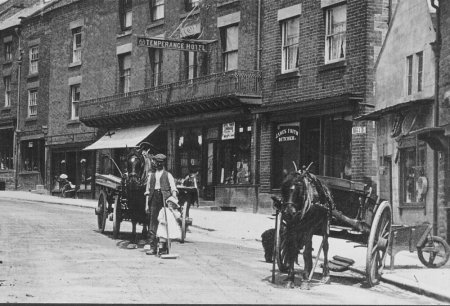
Contact the author on  for an enlargement of this photo, quoting Z493.
for an enlargement of this photo, quoting Z493.
|
St. John Street is, I suppose, the High St. of Wirksworth. I am not quite sure where the Market Place ends and where St. John St. begins, but for convenience let us begin at the Boot Shop.
This was, as now, a Boot Shop. But how different. Owned by the Gambles you knew (Mrs. White and Mrs. Haynes and Sid Gamble the nephew). I knew their grandfather - he lived to be 97 or 98 years old. His son was a genial old man who wore blue tinted spectacles. His was a "superior business". No "sale" stuff ever entered his shop. I still remember his top window was always dressed with one pair of long topped riding boots and two pairs of highly polished leggings. The bottom window showed one pair black boots and one pair brown boots (gents) and a pair of ladies boots which had metal catches up the front which held the long laces which were needed. Apparently these must have reached well up the calf.
Next door, now Weston's, has had several changes.
The earliest one I remember was a butcher's shop. This was Blackwell's (the grandparents of Edward Webster). Three steps up to the shop in those days and of course the Blackwells lived over the shop, and under it is the big cellar room. This was lit by a big grilled window at pavement level and, as all the various potted meats and pies were prepared on the premises, I still remember the glorious odours of cooking which used to come up through the ventilators. Reminiscent of the Bisto kids. The Blackwell son Harry was a great sportsman and a tablet in his memory is in the church. Later this shop became a tailor's and Mr. Land sat inside cross legged sewing by hand on the counter. Two bales of cloth (one navy, one clerical grey) and a book of "styles" was the only decoration in the window. Later this business was taken over by a Mr. Legge. His daughter married into the Smith family of Buena Vista.
Now across the street to Mr. Wheatcroft's. He was a fishmonger and greengrocer. The shop has gone and now is an extension of the "Hope and Anchor".
Approached by four stone steps, the shop was in two halves. Right side was the wet fish on a marble slab, so arranged that the melting ice could drain away through the window and so on to the pavement. Left side was the green grocery. Turn left inside the door towards the counter, quite unapproachable because in front I always remember - bags of potatoes (red and white), bag of carrots and onions and swedes in season. The counter itself held boxes of apples and oranges in season. This made this area inaccessible, so you were served by Mrs. Wheatcroft, who was quite small, suddenly appearing round the corner by the big scales. Your modest orders and all financial transactions were completed on top of an orange box which had three compartments. This was usually full to overflowing and if you "accidentally touched" the bottom one of the pile, a cascade of oranges resulted, and if you were really lucky, several would roll down the steps and into the street. The fish came up by train, packed in flat boxes filled with ice. The empties were kept outside under the window, hence the pavement was always wet. Mr. Wheatcroft became a councillor and became involved in a libel suit with our surveyor over his plan to alter the Market Place (more later). He suffered financially. Incidentally, he had two storage places, a small one which ran off what is now the Church Yard from St John St. The other was in China House yard and went underground.
Next door was a drapers shop owned by Mr. Crannis. I only remember him as a rather ill tempered old man who always wore a tall stiff white collar which held his head erect. He was very brusque and you had to tender your penny for the reel of cotton No 40 (I never understood that) before he would serve you.
Then came the Williams', who you may remember in their later days). They transformed the shop (chiefly due to Mrs.Williams) and it became a prosperous draper's and milliner's. Mr. Williams kept the till. This was a new fangled affair which rang a bell when opened and later showed the price. Other tills were merely drawers with partitions for gold silver and copper. Strange how you remember small things.
Now across the road to the BON MARCHE (a rather grand name for Clay's shop).
It was I suppose a typical country shop which sold everything except food, sweets and ironmongery. Miss Clay and her brother Reg (who you may remember) officiated. The windows held a rather shapeless collection of garments, chiefly ladies ware. Inside one approached the counter via an avenue of linoleum rolls (two patterns, one a bilious yellow, representing wood block I presume; the other in red squares to represent tiles) and smaller width rolls I suppose for stairs as they had the Greek Key Pattern down the edges. The counter held a stand full of bobbins of cotton and an assortment of tape measures which dripped down the back. These were never disturbed because Miss Clay wore several round her neck as a badge of office. Only the smallest orders were dealt with in the shop proper, the more intimate requests were dealt with in the "back", having been transferred there by brother Reg. There is a window near the Lych Gate and, by peeping through, one could watch all sorts of mysterious measurements being taken and materials examined. (In passing) Reg used to cut lengths of oil cloth in the church yard on fine days. (He would) put a stone at one end to hold it taut whilst he unrolled the other end. It was considered a victory if, while he was bending, measuring, you could dislodge the stone so that the lino rolled up and hit him in the back.
Continued next month.......
|
|
.....continued from last month
------------Deadline Mar 31 2008----------------
St Johns Street: Tiger Inn on the left.
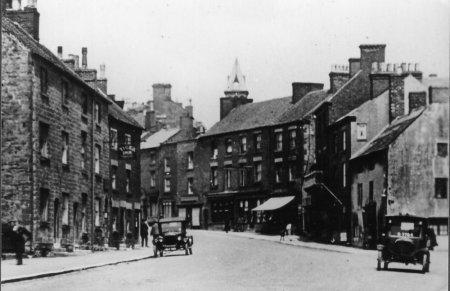
Contact the author on  for an enlargement of this photo quoting Z491.
for an enlargement of this photo quoting Z491.
|
The other side of the Lych Gate opening is now a grocers shop (Bagnall's) that has developed from a small place I will try to describe. It was, in my early days, a baker's shop owned by a
Mr. Lewis. It is hard to imagine, but access was gained via 6 half moon steps so that the shop itself was perched about 5ft above pavement level. The baking was done in the building which abuts onto the church yard. The windows were usually whitewashed, but often got rubbed, and so occasionally it was possible to see Mr. Lewis making his dough and taking his loaves out of the oven. I suppose he must have died or left because, suddenly, it became a grocer's shop. A little man,
Mr. Fields, took over - like most little men he bustled about and was important. He also was looked upon with grave suspicion because he sold at "cut" prices, and had "special offers". This was considered not quite fair and if the goods were cheaper, the quality must be poor. However, he prospered and I always remember his cut price Liquorice Allsorts at 6d (old pence) a lb.
Then came Bagnalls who, a few years later, removed the steps and lowered the shop floor to ground level as it is now.
Next door (part of Bagnall's shop now) was Mr. Woodford's, hairdresser and umbrella repairer.
I remember him as a grey moustached man who stooped (due to some deformity of the spine) and talked, and talked. He belonged to a religious sect called the Plymouth Brethren who had no music and believed every word printed in the Bible and indeed knew most of it by heart. This, you can imagine in a barbers shop, led to much argument (especially if a text was quoted against a local football team that had lost the previous week) and work would be suspended. I don't remember much about Mr. Woodford senior except that he was an avid stamp collector and had a big album, the pages of which he would lovingly turn over. We used to think he was a little touched to collect stamps - what has happened to his collection I wonder? Now to his son Stanley - you will remember him I suppose.
He had a wonderful gift of imagination, in so much that experiences he heard about soon became his own and he could weave fanciful tales which were all in the first person. We were enthralled, but not everybody could understand. It was one of my delights to go for a haircut on Saturday morning when all the "regulars", who were shaved once a week, sat round and Stanley led the conversation, which ranged from Astronomy - Surgery - Wars - Sport - in fact every subject you could mention - and a quote from the Bible (Old Testament, Job and the Psalms chiefly) to clinch the argument. He had been apprenticed at Matlock - so Hydropathy was an open book to him. He also had had a spell in DRI with a blood infection. This opened to him all the realms of medicine and surgery and, although I never remembered him saying he actually operated, he was the confidant of all the medical staff. He also had been in the army (1914-16) and what a field that opened. He would have made a wonderful novelist. I remember so well how he would lather up a customer in the chair, pick up the razor, and strop it and then use it as a baton to point out his arguments. Often, his victim in the chair would mutter complaints and would have to be redone. The crowning memory is of an old man saying: "Stanley, some men are liars - some are B--- liars but thou art a B---- awful liar". He was a competent barber and a mender of umbrellas. The charge was Haircut 1d, shave 2d.
Next door was a watch repairer (a Mr. Bowmer).
So, you see, the premises now occupied by Bagnalls was originally 3 separate shops, each paying its way and each had families living above the shop.
Next door down the street was the butcher,
Mr. Rains and family. These I need not describe because you knew them well, except to mention here that they bred their own cattle and slaughtered them themselves, prepared all bits and pieces, made all the sausages etc. There are not many butchers who could do that nowadays. The family were (and are) devoted Primitive Methodists and, if I get as far as religion, shall mention that in such a section.
Mr. Tom Clay had a small shop below. He was a boot repairer and his shop offered for sale the stoutest boots and shoes. His workshop was on the top floor - now plainly visible from the churchyard. Mrs. Clay always wore a flat cap and Mr. Clay, each night, lit a small clay pipe and vanished on a mysterious walk which I believe took him round the local inns, behaviour which I understood was very dubious. I should be about 5 or 6 in those days. I believe Mr. Clay died, and afterwards his sister
Lizzie appeared to look after things till we took over.
Across the road, Mr. Mee's shop was owned by a
Mr. Land, and Mr. Mee was the tailor who made the trousers – Mr. Land made the jackets.
This was understood and seemed to me to be a curious arrangement. After Mr. Land died, Mr. Mee took over the business and still at an advanced age is quite active. It is hard to believe that, in those days, ready made clothes were hardly known - all were made by hand from picked material and were made to last.
Continued next month.......
|
|
.....continued from last month
-------------Deadline April 30 2008---------------
St Johns Street
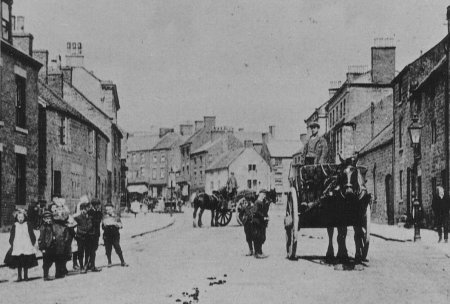
Contact the author on  for an enlargement of this photo quoting Z190a.
for an enlargement of this photo quoting Z190a.
|
Now we come back to our side and to our shop, which is now the electrical Corner House establishment.
We were
old-fashioned grocers and when I think of all the work that that entailed I shudder. Everything was weighed and packeted, often while the customer waited. Tea was blended and packed up to customers' own requirements (we had a little tea-book which gave particulars of certain customers' preferences). Coffee was ground fresh each day. Orders were packed up and delivered. Tuesday was particularly busy because the farmers' orders had to be ready so that they could get back for milking, and we kept open until 7.30 pm on normal days. I must write a section on these years at a later date, and so pass on.
The shop below was a butchers shop, for a little while at any rate, kept by a Mr. Frith. He was not mentioned in our house because he drank. He disappeared suddenly and the
Bowmers came down from higher up and so the shop became a watch maker's. Then, strangely, he disappeared, and left Mrs. Bowmer, two sons and a daughter to manage as best they could.
You will both remember quite well the passage way into the churchyard and the "stoop". Now all that area has been demolished due to disrepair but in those days this was a busy corner. We had a stable which, before my day, used to stable the horse and trap which was used for delivery. Later we used it as a store place for empty cartons. Incidentally, in one corner was a "copper" in which we used to boil our own hams. Next door was
Mr. Rains the butcher's store room and the place where Joseph prepared the meat and made the sausage. The house above, which fronted the churchyard, belonged to
Mrs. Travis and her daughter Edith.
Mrs. Travis, who was a small stoutish woman, was always dressed in decent "black sensible material", (and) was disliked because she would not allow anyone to play outside her house, and indeed complained waspishly about even any noise. You will understand her troubles when I say that this part of the churchyard was the playground for 3 Haworths, 2 Rains, 3 Woodfords, 2 Ballough (?) and their friends. Miss Travis was a dressmaker with quite a good business, I should imagine, because she had two apprentices. Miss Travis used to visit various farm houses and live with them while she made up clothes for the women folk. It was suspected that this was, first, to get away from mother and, secondly, she lived cheaper and better. Perhaps we were ungenerous.
That was to the right of the "stoop". To the left lived for a little while (as I knew) the Friths, parents of the Friths who are builders. After them came two old ladies whom I thought were most kind and we (the children) were allowed to pop inside and watch one sitting knitting and the other preparing food. I believe we owned the cottage - this might have influenced them. Later a Mrs. Goodall lived there. She was a cratchety old lady - but I suppose we as children playing round about must have been noisy and a nuisance. Rains' lived (as now) and the back door came into the churchyard. So much could be written about that family - you both knew them well. How just and meticulous they were in all their business. I have known Miss Rains come down here on Saturday night at 9pm with a ½d which she had discovered she had overcharged earlier in the day. On the other hand, 1lb of sausage was exactly 16oz, even if it meant cutting a link in 4 parts.
Now we pass below "the entry". How changed that is now the old buildings have been demolished. Above the cottage was our warehouse, a three storeyed building. I will talk about that if I ever get round to describing what life was like at "our shop".
Below "the entry" was a typical piece of old Wirksworth.
The buildings still stand (in 1974). First came a little bakers shop kept by the Salt family (they or Miss Salt transferred to West End). The baking was done in the building up the yard. Plain fare, bread, oatcakes, rock buns. Money was very scarce in those days and only plain fare was known in most families. Later these premises became a fish and chip "saloon" kept by the Pearsons, whose relatives live in Australia. The daughter married George Spencer, who began his chequered career there, later transferring to the Market Place.
The building(s) at the back were used by Mr. Clay and Sons as their boot and shoe repair workshops. This had two stools which were reserved for callers who just sat and talked whilst work was in progress. As you can imagine, it was a hotbed of scurrilous gossip. During the First War a great change occurred. The second house (cottage) down which was occupied by
Mr. Johnson, the blacksmith. He obtained a contract for making horseshoes for the army and so set up business as a shoesmith. Horses of course were still the accepted means of transport and power. The farm tractor had not arrived. So, all day and well into the night on occasions, we lived in an atmosphere of "chink chink" as the shoes were fashioned, and we were often called in to work the bellows. I remember with glee one incident. Johnson was attempting to shoe a donkey (more of him later). The donkey was obstinate and kicked out. First went the owner. Then, Mr. Johnson, trying to evade flying hooves, fell over his work box and was trampled on by the donkey. Johnson got up and his hand was near his light hammer, which he picked up and hit the donkey on the head. The donkey turned round, bit Johnson on the backside, then walked out down the entry and out onto St John St, and stood near the big wicker basket it usually pulled. The language was colourful, as you might imagine, but the donkey never came again.
Continued next month.......
|
|
.....continued from last month
------------Deadline May 31 2008----------------
St Johns Street: R.H.Haworth shop with balcony.
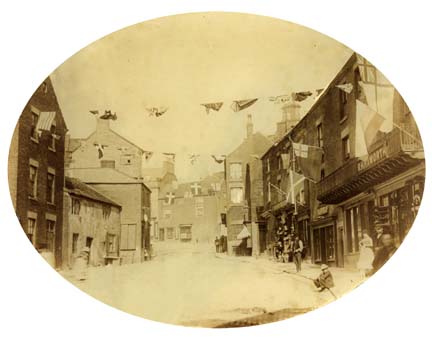
Contact the author on  for an enlargement of this photo quoting Z043.
for an enlargement of this photo quoting Z043.
|
Now we come to one of old Wirksworth's character shops. Now a decorators shop, it was then a grocers shop, which also sold pots and crockery, kept open by
Mr. Stafford (the father of Councillor Miss R. Stafford who you will remember). I say "kept open" because he was rarely in - but everyone knew that he would be across the road in the Tiger Inn and either fetched him or helped themselves. Charlie always came to our house every week end to "borrow" a side of bacon or half a cheese to put him on. The shop was in two halves. Pots on the floor on the left and groceries on the right. Brushes etc hung outside, making entry to the shop difficult if he had just had a delivery of "Farm Brooms" because you had to push your way into the shop. Charlie was one of Wirksworth's real old characters, always in white apron and a straw hat. He would stand at his shop door and engage any passer by in fierce argument and finish all by saying "I bet you ½ pint. Shall we pop over and have one?" He must have lost money - I know we did! His monthly settlements never seem to arrive. However, he wasn't the only one who defaulted.
Next we come to Maskrey's
sweet shop.
Janet is the second Mrs. Maskrey. I well remember the first one and her mother. Mrs. Maskrey No 1 was always in the shop, which was not so crowded and more tidy than now. This gave her a wonderful vista - up the street and down. All the "goings on" were duly noted and related to a privileged few. She sold home-made sweets and butterscotch. This was set in flat tins and was broken on request with a toffee hammer. If she was in a "paddy", the tin was hit very hard and the toffee you received was in splints. On a good day you got selected pieces.
Next door was, as now, a barbers shop, kept by a Mr. Joe Fell, a dapper smaller man, dark hair, ever neat and tidy. He was in great demand at local dances. So much that one night he eloped with a girl from Kirk Ireton and was not seen for many a year until someone saw him officiating in Lyons Corner House. He never came back. In his place came a young lad, now of course Mr. Wm Smith.
You will remember the shops that stood at the corner of St Mary's Gate.
The first was a fish and chip shop, kept by a Mr. Southam and family. You know his grandchildren. Before they took over it was kept by Mr. Clapham. His daughters attended our chapel and sat behind us (2 pews away). They always had the frying aroma and always ate peppermints.
The paint shop was
Mr. Websters', who employed two men. His shop was our only supply of wallpaper etc.. Mr. Cooper's shop was a private house and below where Wain's now stands was a secondhand furniture shop.
Mr. Miller, the proprietor, drank more than was good for him and often the door would open and out would come Mr. Miller followed by a chair or whatever furniture was handy.
Slater's shop was kept by Mr. P Gamble.
He had a curious stock of cleaning material and paraffin. He had moved down from the Dale. He and his shop always betrayed the fact that he sold paraffin and even his "donkey stones" smelled as he did.
Then we come to what I always thought was Wirksworth's best house. This was Nether House, which was a grand, creeper covered, Georgian House which was comparable in size to the opposite house (now the hospital). It had spacious grounds which extended down to the Hannages - good lawns and gardens, which included a peach wall (now the back of Bill Wilde's house in Nether Gardens). It was owned by a
Mr. C. E. Bowles who was a scholar of some repute. Alas, the War impoverished them and they had to move to a smaller house on North End. I well remember him presenting me with a prize at WGS called "Our Country's Flowers", and being invited to go with him on a tour round his garden and receive a lecture far above my head. There were stables approached by an archway on to St. John St. and he kept a good staff of servants. He had a young parlour maid, now Mrs. Sam Smith, so you can guess how long ago that was.
For a while after he left it was a guest house and we used to hold suppers and dances in the big dining room. This house gave distinction to the street. Now, of course, it would be preserved. Then, it was just knocked down and the present cinema was erected. The building (that is) now the Memorial Hall was a club and this flourished until the War came.
Continued next month.......
|
|
.....continued from last month
-------------Deadline June 30 2008---------------
St Johns Street:
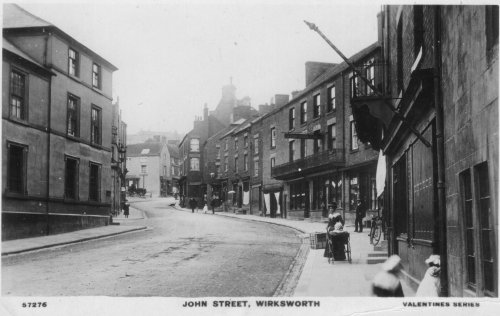
Contact the author on  for an enlargement of this photo quoting Z024.
for an enlargement of this photo quoting Z024.
|
The remainder was almost as now, except the chip saloon (which) was a private house occupied by a retired solicitor and his wife.
The little shop was a grocer's, kept by the Gambles, both noted characters.
Mr. Harry affected a straw hat and white apron. Summer afternoons he would appear on the Hall Leys at Matlock, resplendent in panama and white flannels, dodging his wife, Drucilla, who had stalked him from Wirksworth.
On the top of Warmbrook were two pubs.
One, now the house of Mrs. Wilson, the other the Wheatsheaf. Only the two cottages separated them. Bannisters Yard was a narrow strip with cottages both sides. Hard now to imagine what it was like.
Back again to the top and the other side - to Lloyds Bank.
Banks in those days were superior places and one entered as if into some ducal establishment - in fact very few people went in. The shopkeepers took money in, but the ordinary people never crossed the threshold. The manager was Mr. Tompkins. He was a captain in the Territorials and on high days and Sundays would appear dressed in his scarlet uniform, compete with sword. We held him in some awe. He had a young bank clerk at his beck and call. He was, of course, Brian Hilditch, of whom more later. In those days the Bank House was run by a staff of about 3-4 servants, so was considered quite an establishment. Below was the Trustee Savings Bank and over it lived one of the curates.
Then, over Hammonds Court (Meadow Road), to one of the notable shops, Buxton's the Pork Butcher.
They were a musical family - they all sang and played. They did this very well, but very loud, and many times, while his daughter (Mrs. Slater) played and sang in the house, Mr. and Mrs. Buxton would join from inside the shop. All work would be suspended and Mr. Buxton would conduct with his carving knife until the song was finished and then afterwards (would) carry on oblivious to the fact that everybody was waiting. We understood, but any strangers in the town were dumbstruck. He was a fervent member of the Cricket Club. He wielded his bat like a chopper and every Monday morning he would demonstrate to any passer by how he "got out" with whatever tool he had to hand. It was dangerous at times to pass his shop because suddenly he would shoot his arms out of the door to sharpen his knife on the steel, and if you were too close you caught the sparks. The window was a good sight - full of all pork by-products - sausage, polony, brawn, black pudding etc.. Very colourful. They had pork products for every meal and so the whole family had pale and full complexions.
Then to the Tiger. This was kept by the
Pashleys. Mr. Pashley was the Cricket Club's slow break bowler, very fat, very slow and deliberate. As a lad he used to bowl me out regularly at practice and I never knew why. Now I know; I lost him in the air. He used to try to sneak out the back way to be early for cricket. Often he failed and, at the call from his wife, would return and leave his bag outside in Meadow Lane. If anyone saw it they would report that: "We had better bat. Charlie will be late today."
Two doors below lived Mr.Joseph Talbot.
He had a stable of horses and provided a trap and a carriage called, I believe, a Victoria. This was our means of local transport. He also, of course, had a "flat dray" and did light carting. He had two (claims to) fame. He had a son,
Joe, who obtained a scholarship to Cambridge University from our local school - this set him apart from ordinary mortals. Secondly, he had been a cavalry man in, I suppose, the Boer War and occasionally would appear on the Recreation Ground complete with sword and give a demonstration of cut and thrust accompanied by wild yells - most awe inspiring to we children. He could be listed among Wirksworth’s characters.
Continued next month.......
|
|
.....continued from last month
-------------Deadline July 31 2008---------------
St Johns Street
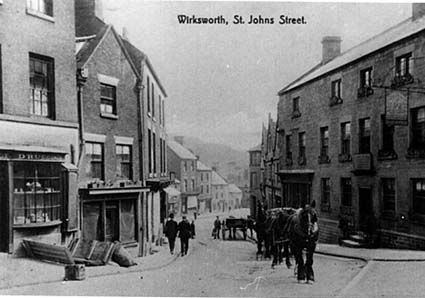
Contact the author on  for an enlargement of this photo quoting Z006.
for an enlargement of this photo quoting Z006.
|
Then we come to another of Wirksworth's characters. This was
Phoebe Wheeldon, a tall austere black clad old lady who, strangely, had a small farm on the site of Arkwright Street. Each morning and evening a solemn procession would wend down St John St and into Foggs Entry, led by Miss Wheeldon and followed by her helper, a
Miss Pearson carrying a yoke with two buckets. Empty as they went, but on the return journey full of milk, which was later delivered by Miss Pearson door to door. Who did the milking, we never knew. The barn door was closed, but we were sometimes allowed to walk the cows in from the field. She (Miss Wheeldon) was held in great respect because she belonged to some select religious sect - akin to the Quakers who did not mix with any other people. (I was given to understand that the last headmaster of the Grammar School
(Mr. Berridge) used to attend these cottage services - because these were held in her house.)
Now it is Waltham House, the Wheatcroft family’s residence.
The house is almost as it was in the early 1900s. The Wheatcrofts, as you know, were tape manufacturers. They owned The Harlem Mill, The Speedwell Mill, and the Bleach Mill (Wash Green) and were one of the largest employers of labour. The family was 4 sons and one daughter. Two sons were casualties of the 1914-18 war. It is hard to imagine what sway this family had over many families in Wirksworth. The family were strong Congregationalists, and if any of their employees had not been to service on Sunday an explanation was required. How different today. They also owned Millers Green (then a separate village) and the farm (Wards) - The Barrell - and succeeded in closing it after purchase. They also owned Stonebridge Farm (which our grandfather was tenant - until after the war when it was purchased). They kept a full staff of servants who all had a good training in their particular spheres. Later, the war and the depression broke the business and, after the death of the parents Wheatcrofts, the sons carried on the mill with diminishing success. Now that family has died out and Wirksworth is not quite the same.
The Mill, now under new management, makes many more lines for many uses. Fashion has changed and dictates the need for a large range of narrow fabrics. So, prosperity has come again and the employees are now well paid, and indeed there is a shortage of staff. The House was left vacant after the elder Wheatcroft's death. The sons had, of course, their own establishments and so we all got together and the house was purchased to become the New Cottage Hospital, replacing the old one up in Babington House, Greenhill. This was one of the social changes which I may recall later.
The remainder of St John St is almost intact.
The Foggs Entry has now been renovated and the cottages are quite attractive inside.
Before I wander any further, may I make a few comments. All these people lived over their business premises. That meant that we were a community of self sufficient people - there was no need to go out of our immediate surroundings for the necessities of life. Nobody had a lot of money (we children had none) and the people worked to live, which was all that was asked. Our needs were simple and our social life centred round the Church and Chapels (more of that later). Children made their own amusement and although some were indeed more affluent than others, this did not raise any social barriers as it does today. I have named the shops in St John Street and you can see that to live we had no need to leave our area. The children, and each family would have several, all played in their own locality and although we all, without exception, had many household chores which we were responsible for, we were all together as a little community and as far as our family was concerned, there was no inter-parental quarrelling and any one in need or trouble was assured of help given in the kindly way that only such a grouping can afford.
We differed in many ways - I suppose chiefly due to religious persuasion (as each society had its own social gathering and cliques). I may be able to enlarge on that theme later. I suppose our family was fortunate, we were accepted by all and there was no social life in the town or indeed any household in which we were not welcome. This was due, I now know, to the high moral standing our family had maintained in Wirksworth for many years.
Continued next month.......
|
|
.....continued from last month
-------------Deadline August 31 2008---------------
Market Place: Hiltons, Hunters, Marsdens
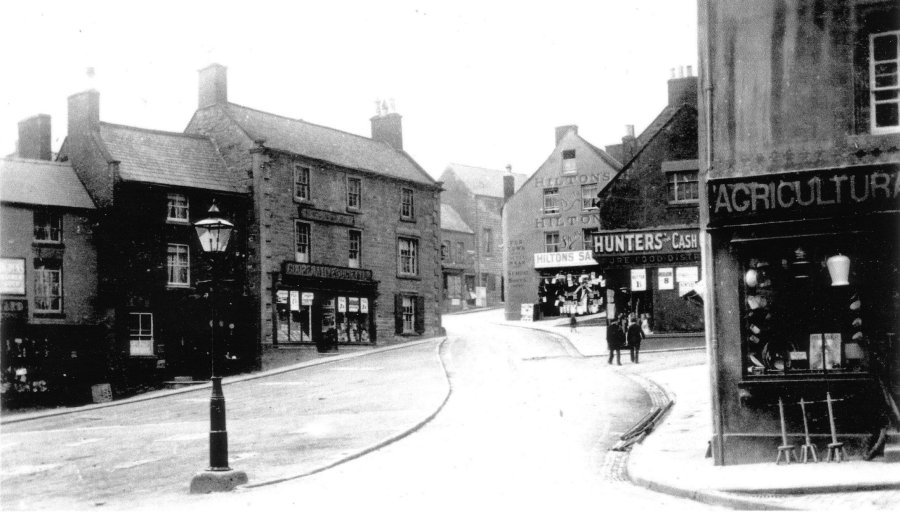
Contact the author on  |
West End: An accident to Hunters.
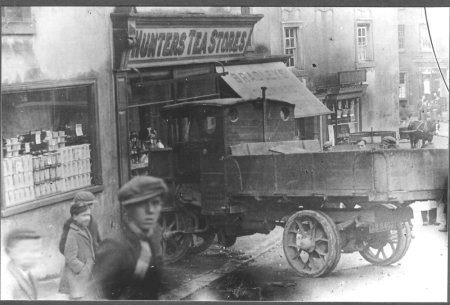
for an enlargement of this photo quoting Z558 and Z468a.
|
The Market Place:
This is probably the most altered and changed area of Wirksworth, structurally at any rate.
What follows is a rough sketch of Market Place No 1 as it was until say the 1930s.
Shall we start at the West End, the top of the Market Place. This was the Pig Market and was an area which was cobbled with stone sets and, on market days and fair days, it was here that farmers brought their pigs to be sold. Bundles of hay and straw and wooden palings helped to keep the pigs confined to that area. The noise and the smell gave a proper farmyard atmosphere. Below that was a long building which stretched across the top, from The Road (West End) to within 10ft of the doctor's house and level with his front door.
This was, in early days, a milliners' establishment and here were made the dresses and hats for the "better off" ladies of Wirksworth. I have been told quite a lot about that because my mother was apprenticed there and was on staff for some years. Upon the death of the proprietor, a Mrs. Hall, the premises were turned into a Conservative Club. I have spent many happy hours as a guest of members. I could not become a member because our family had a Liberal tradition to maintain. However, in my youth, I was considered a useful snooker player (I do hold the record of 52 for Wirksworth snooker), so have played there in several challenge matches. Supposed to (be) evidence of a mis-spent youth if you are fine at table games.
Below, on the Market side, was
Mr. Millington's shop. A remarkable man - who could clean and repair any mechanism if he so wished. He was one of our real characters. Apprenticed in Derby, he cycled down to Sadler Gate in Derby on Sunday evening to be ready to start with his foreman at 7 o'clock am Monday. At night he slept under the counter in the shop and returned to Wirksworth on Saturday night after 8pm. Later he worked in Wirksworth and took over the business when Mr. Evans the proprietor left to open a shop in Matlock Dale Road. One prospers and one just lives and enjoys life. Mr. Millington was a keen gardener and an unscrupulous competitor at the local horticultural shows. So flagrant were his actions that finally he was (de)barred from all competitions. He also was a keen rabbit man and always kept ferrets and gun dogs. He had a dog which slept under his work bench next to the ferret box. His shop was the meeting place for all the men of his ken. Little work was done, but much libelous conversation was heard. He was also a great beer drinker. A type of Wirksworthian we shall never see again.
Down again to a tobacconist shop kept by a
Mrs. Pickard, who was stone deaf. It was considered a joke to slip into her shop, quietly whilst she was arranging her stock of cigarettes, and suddenly yell, causing confusion etc. She was so deaf that she was unable to say if this had been done on purpose - that is, if you kept your face straight. Otherwise you were reprimanded, then reported - that meant a good hiding. All considered in a day's march. Below again was the house with the door opening onto the market.
We are now down to within 10ft of the Hope and Anchor. This area has also changed. Where now is the dining room of the Hope and Anchor was a shop. I remember it as
Palin's, the green-grocer, in my early days - later they moved across the Market. But, for many years after that, it was a baker's shop kept by a
Mr. Brough. His bake house was across the narrow Causeway as shown on the map. Mr. Brough's son was Charlie who you knew so well. Imagine the smell of hot new bread which came from out of the bakehouse. One could stand outside and see the loaves, cakes and buns being taken from the oven. He also baked meats and made Cornish Pasties and sausage rolls. Next door again was the
Miss Greatorex's establishment, who sold home made sweets and everlasting sticks and liquorice bootlaces. For 1d one could have a night's enjoyment from Miss Greatorex. The shop had a paned bow window and it was one step down to the counter. This corner I now can see was a typical Dickensian corner, also all gone.
Opposite was, as shown, two cottages. These cottages and the bakehouse formed the base of an isosceles triangle of buildings. Across from the cottages was a curio shop kept by a
Mr. Millward. His shop was a curious jumble of bric-a-bat. I never knew if he sold anything. I remember he had gold rimmed glasses on the end of his nose and he took snuff. This, we were informed, was a "dirty habit" and he was looked on with suspicion.
So there we have one side of the Market which has now all disappeared. It was demolished in one of Wirksworth's great upheavals, but quite recently, perhaps 1930. As that needs recording, perhaps that might need a special paragraph later.
Continued next month.......
|
|
.....continued from last month
-------------Deadline September 30 2008---------------
Market Place: Marsdens
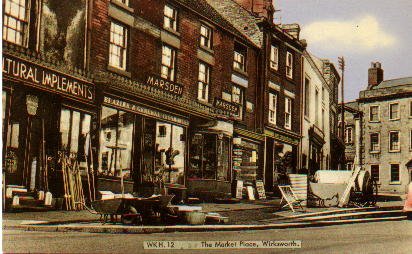
Contact the author on  for an enlargement of this photo quoting Z124.
for an enlargement of this photo quoting Z124.
|
Up to the other side of the "Market Place No 1". Structurally, this side is almost the same, although the uses to which the premises have been put have altered.
The Building Society's place was Hilton's Boots Shop (kept by
Mr. Pattin). Then the Black's Head (as now). Below was the London Central Meat Shop and then Hunter's shop.
These two are now combined into the Laundromat. Palin's shop was the Crown Inn, a very old establishment with extensive stabling in the rear.
Then Bradley's and so down to
Marsden's at Scotts Corner, so called because years ago a cripple called Scott used to sit at the corner for many years.
Now it is still used as a vantage point because one can see down St. John St., across the two Market Places and have a good view in those days of who went into the Hope and Anchor, the Black's Head, the Crown, the Greyhound and the Red Lion. Now the Crown and the Greyhound are closed.
Marsden's are of course a very old business house which has seen many ups and downs.
They were farmers' ironmongers and sold machinery such as was used in those days, and milk churns. In those days, farmers provided their own churns and each had a brass tag on the top bearing the owner's name. If a farmer sold three churns he had to have at least six: 3 out, 3 in. His milk was sold by contract to firms in the large towns and it was a great day for the farmer when the firms came to "buy the milk". Most from round here went to London and the farmer brought his milk to the station by cart to catch the 5.20 train. Imagine the station with say 40 carts each to unload and load up all the churns and the chaos that occurred. These contracts were binding for so much milk - in good condition at the firms depot. Any short was surcharged, and so any over was made into butter and cheese. Most farmers kept on the safe side and so the farmer's wife etc was kept busy. This is all by the way. I was talking about Marsden's, a prosperous business until after the wars. Then, between the wars, we had Nestles, who started a factory in Ashbourne (incidentally, I believe they wished to come to Wirksworth in the first place). They provided their own churns and collected the milk from the nearest road to the farm. This of course set the rot in as the farmers naturally stood to gain, especially as they were paid for all they sent. Their churns were also a different shape and did not hold so much (and of course were not so heavy) so these were soon mass made and Marsden's work got less and less.
The business was reorganized and the son(s) took over and concentrated on the farm machinery connection – which it holds today.
Mr. Marsden (Jack's grandfather), I believe, had been married twice and Mrs. Marsden had two families - so the relations were most complicated. My uncle married a Marsden and my aunt (Aunt May) married one of Mrs. Marsden's brothers. The family were all Wesleyans (one daughter married one of our parsons). I may be able to include some history either in a section for old characters or in a section on the religions.
Next door (now the paper shop) was kept by
Mr. Harrison (Ken's father).
He was a plumber and decorator and they kept the shop with wallpaper and paints – and (strangely I always thought) good quality pottery (teasets and dinner sets etc). Access to the back door was via the Crown Yard and behind the stables and the slaughterhouse of the butchers (higher up the Market Place). Ken Harrison was one of our group who played in the Church Yard. Next door was a tailors shop
(John Willy Land) who later moved to St. John St. after Blackwell Butchers died out. The shop was taken over by
Mr. Hawley, an extension of his Greenhill emporium. Mr. Hawley always wore a straw hat and a striped apron. Except on Sundays when he appeared immaculate in black suit and highly polished boots which squeaked – causing consternation in the Baptist Chapel morning and night – he always was last to arrive and bowed and smiled his way slowly down to his own pew in the front. I think he should appear later with Mr. Marsden.
Next again was, as now, a butcher's shop, kept by a Mr. Ogden who married a Miss Blackwall (see St. John St.).
Continued next month.......
|
|
.....continued from last month
-------------Deadline October 31 2008---------------
Market Place: Marsdens, Bothams
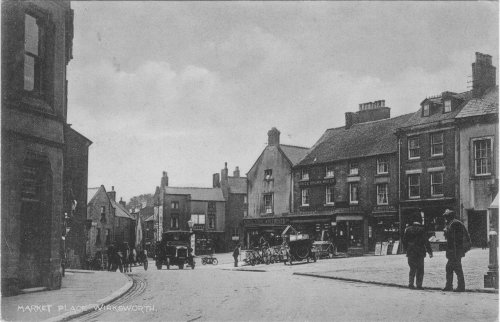
Contact the author on  for an enlargement of this photo quoting Z202.
for an enlargement of this photo quoting Z202.
|
Next door (where now is the Super Market) was a draper's shop
(Mr. Fox).
He sold material and his windows were always full of rolls and rolls of various cloths. His business was mostly with the bigger houses. They all employed a seamstress whose duty it was to make the bed linen, the dresses for the servants, the curtains etc. A most important shop (he was also a bell ringer at Church). Upon his death, the shop was taken over by the Co-op who branched out in ready-made dresses.
Above again (now a pet food shop) was
Mason's the Chemists. A real old fashioned alchemists shop - well respected and, in those days before any NHS, acted at the people's first call in illness.
Symonds House on the other side was, as now, a private house but round the corner in the Dale was the solicitors office.
Before the New Road (Harrison Drive) was constructed, the entrance to the road was occupied by two shops.
The first was a small sweet shop which also sold biscuits and tried at a later date to branch out as a tea shop. This failed because both Miss Doxey and her brother William were eccentrics. The other shop stood empty for some time and was then taken as a second-hand furniture shop by some people from Manchester called Watts. The sons later started the motor and taxi business you know. I expect that I shall be able to talk about that service under another heading.
We are now down to the Red Lion which was as now.
In early days this was a noted coaching inn and has extensive stabling up the yard. At the top of the yard was the bowling green which was one of Wirksworth's "better class" affairs. Alas this was destroyed when the new road cut straight through - and so Wirksworth lost another amenity.
I shall include the Town Hall in the Market Place because in those days it was part of the market scene.
You are aware of the plan – if not, the following sketch may help.
The bottom portion (now the Rates Office) was a butchers shop (Abbott's). Old
Mr. Abbott was a rough loud man who kept his family in complete subjection. His daughter was for many years a teacher at the School and followed his example with her pupils. The portion above the entrance was used to store the market stalls etc by the UDC (Urban District Council). Round the corner were two spaces which were used on Market Days by the farmers' wives and daughters to sell butter, cheese, eggs and in the other one rabbits, poultry.
This was an essential part of the wives' income as that money was by custom the housekeeping for the farm. This custom fell out of use with the decline of the private sale of milk and its collection by the big combines from the farm itself. This I will try to remember when we talk about changes of customs.
Incidentally, we used to have an Orange Fair on Pancake Day and the space in front of the Town Hall was occupied by stalls selling oranges. (That was the day when everybody bought oranges for
marmalade and we sold 3x2lb sacks of special sugar for preserving in that week. It was all hand weighed and packed after school.
Continued next month.......
|
|
.....continued from last month
-------------Deadline November 30 2008---------------
Market Place: R.Johnston the Ironmonger
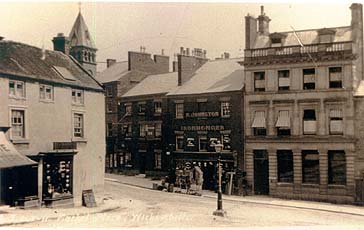
Contact the author on  for an enlargement of this photo quoting Z021.
for an enlargement of this photo quoting Z021.
|
The shop you knew as Miss Stokes' was kept by
Mr. Atkinson, [see oldphoto X027] a white haired, jocund man - stoutish, with a white apron and gold watch chain.
He had two men with him in the shop and one man whose duty was delivery and general warehouse duties. The business was really high class and he supplied all the big houses in the district. I remember him sending me home with a note asking for the loan of six sides of bacon to complete an order for Willersley Castle. Have often wondered how big the order was. However we were friends and I always think of him as the typical Victorian grocer. He was a kindly man and very knowledgeable. He kept the weather records for our area, was a keen gardener and botanist, willing and able to talk to we children about any allied subject. He started several of my friends in the hobby of wood samples. He was a big churchman and gates to his memory were installed at the Church porch, iron ones to replace the wooden ones which were falling into disrepair.
I remember his housekeeper (Betsy) a stout white hair, steel rimmed bespectacled lady who made rock buns which often went free. He lived in the Manor House and his horse and delivery cart was kept in the stables at the side of the house.
Round to the front of the Market (the East side): Structurally as now, but occupied first by Mr. Land,
[see oldphoto X027] the drapers shop.
This was a large establishment which employed quite a big staff. What is now Hilton's was
A.J. Marsden, the stationers with the auctioneers office over the shop. This was a big shop and sold general stationery material, newspapers etc.
Next came one of Wirkworth's rather unique shops. Kept by the
Miss Smedleys, two refined old ladies, who sold only home made bread and cakes and provided afternoon teas of a delicate nature. They baked in the back of the shop (I can smell it now). The entrance was up two steps and the shop window was of the old bow type - with small panes - that are coming back into fashion in 1974. In those days it was "the thing" to meet at Miss Smedley's. Funnily enough I never remember it being called just Smedley's (always with the prefix "The Miss"). With their demise, Wirksworth lost a link with Georgian and Victorian living.
Next door was the Greyhound Hotel, which closed in my early days. I just remember it, and standing in the door way to watch the soldiers (Territorials) parade.
Where now is Hunters was
Mr. Johnson the ironmonger - an ardent baptist, and so the supplier of that class of good and paraffin to all the non-conformists in the town.
He was a lay preacher and got very emotional during his sermons and had to stop on many occasions to weep. I suppose he must have been very sincere - in those days I thought he was just (a) plain show off.
Then the bank, as now. The manager was a Mr. Coulson - his son was in the flying corps. He brought down the German flying ace in the 1914 war, got wounded, came back to WGS for a refresher course, went on to Cambridge, fell out of a punt and was drowned. His father was a particular pal of mine (though of course much older).
Then next door was
Hindles The Farmer Chemist, an old established business, probably 1750.
Where now is Read's shop was then
Shields the tailor. His window carried a bale of clerical grey cloth in one window and a pair of check trousers in another. His daughter was Mrs. Hardy the mother of Alice Hardy (Cromford Road) who died so tragically with Miss Reece a little while ago. Very genteel was Mrs. Hardy and used to slip down the Church Yard with a jug each night to fetch the beer.
The Hope and Anchor was kept by the
Budworths who had owned it for a generation.
In fact an old Mr. Budworth was the first customer the Ind Coope had when they started brewing at Burton.
There are many tales to be told about the Hope and Anchor. It was reputed to be the site of the Roman Governor of the prison camp which they established here about 10 AD. It features in Baroness Orczy’s book Beau Brocade and was the meeting place of the Barmote Court. But, above all, it was a superior establishment noted for its exclusive clientele (which never numbered more than a dozen).
I may be able to recall for you the consternation caused when overnight we received 750 soldiers chiefly Cockneys who did not understand the niceties of Wirksworth's pubs.
-------------End---------------
|
|
Compiled, formatted, hyperlinked, encoded,
and copyright © 2007,
 All Rights Reserved.
All Rights Reserved.
|





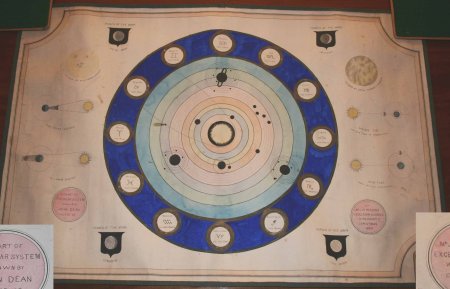
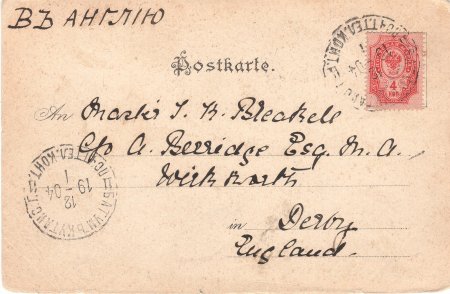

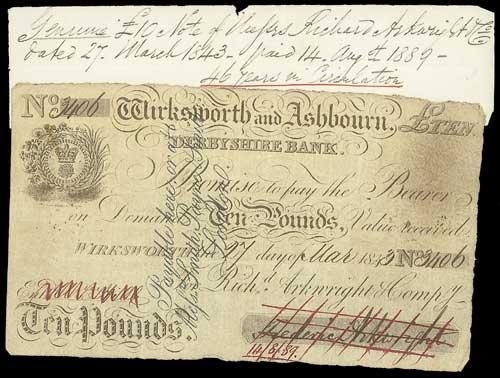

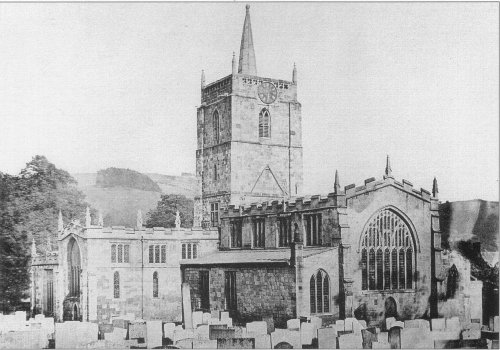

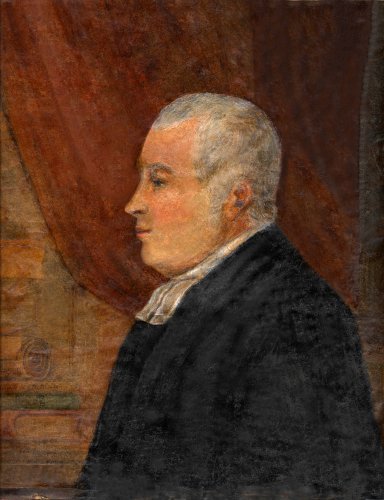

 for an enlargement of this photo, quoting Z493.
for an enlargement of this photo, quoting Z493.









